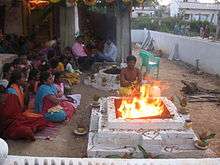Vedi (altar)
Vedi is the term for "sacrificial altar" in the Vedic religion. Such altars were an elevated enclosure, generally strewed with Kusha grass, and having receptacles for the sacrificial fire; it was of various shapes, but usually narrow in the middle.
- mahavedi, the great or entire altar
- uttaravedi, the northern altar made for the sacred fire (agnyayatana)
 Vedic Fire Altar.
Vedic Fire Altar. - dhishnya, a sort of subordinate or side-altar, generally a heap of earth covered with sand on which the fire is placed
- drona, an altar shaped like a trough (Shulbas. 3.216)
- adhvaradhishnya, a second altar at the Soma sacrifice
The uttaravedi was in the shape of a falcon (alajacita = "piled up in the shape of the bird Alaja"), and was piled up with bricks in the Agnicayana ritual.
Vedic altars are described in the circum-Vedic texts dealing with Kalpa (the proper performance of sacrifice), notably the Satapatha Brahmana, and the Sulbasutras say that the Rigveda corresponds to an altar of mantras.[1]
Fire altars are already mentioned in the Rigveda. According to Taittiriya Samhita 5.2.3., they are made of twenty-one bricks.
In ŚBM 10.4.3.14-20, the altar is made of 396 (360 + 36) yajusmati (special) bricks, and of 10,800 lokamprna (ordinary) bricks. 10,701 lokamprna bricks belong to the ahavaniya altar, 78 to the dhisnya hearths and 21 to the garhapatya. Around the altar are 360 parisrita stones (261 around ahavaniya, 78 around dhisnya, 21 around garhapatya).
ŚBM 10.3.1. describes that the altar is symbolically built with gayatri (24 syllables), usnih (breath, 28 syllables), pankti (mind, 40 syllables), tristubh (ear, 44 syllables), jagati (48 syllables) and generative breath. The gayatri altar's height is to the knees, the tristubh's to the navel and the jagati's to a man's height.
Agnicayana
| Layer | Number of yajusmati bricks in SB |
| 5 | 138 |
| 4 | 47 |
| 3 | 71 |
| 2 | 41 |
| 1 | 98 |
In the Agnicayana ritual, the mahavedi (great altar) has a length of 24 prakrama in the east, 30 in the west and 36 in the north and south.[2] Inside the mahavedi, an altar is placed. In the smaller ritual space to the west of the mahavedi (pracinavamsa, pragvamsa), three altars are placed: the garhapatya (earth, W), ahavaniya (sky, E) and daksinagni (or anvaharyapacana, SW). The round garhapatya and the square ahavaniya have the same area.[3] The Squaring the circle problem was also investigated because of such ritualistic considerations.[4] The ahavaniya altar has five layers (citi), representing earth, space and the sky.
Archaeology
At Kalibangan (at the Ghaggar river) the remains of what some writers claim to be fire altars have been unearthed.[5] S.R. Rao found similar "fire altars" in Lothal which he thinks could have served no other purpose than a ritualistic one.[6]
See also
Notes
References
- Subhash Kak. Birth and Early Development of Indian Astronomy. In Astronomy across cultures: The History of Non-Western Astronomy, Helaine Selin (ed), Kluwer, 2000
- Subhash Kak, The Astronomical Code of the Rigveda, Delhi, Munshiram Manoharlal, 2000, ISBN 81-215-0986-6.
- Sen, S.N., and A.K. Bag. 1983. The Sulbasutras. New Delhi: Indian National Science Academy.
- Frits Staal, Agni, the Vedic ritual of the fire altar (1983).